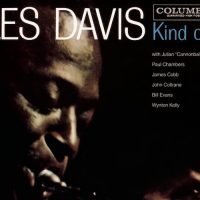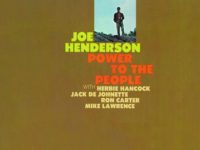Jimmy Cobb, the primarily self-taught drummer who rose to prominence in jazz during a five-year stint with Miles Davis beginning in the late 1950s, takes us inside the free-form sessions favored by his old boss. We also find out about the courtroom battle that followed one of Joe Henderson’s most famous late 1960s projects, while elsewhere Cobb provides insights into memorable sides with John Coltrane, Christian McBride and Hank Jones …
“ALL BLUES,” with Miles Davis (KIND OF BLUE, 1959): A 12-bar blues performed in 6/8 time, “All Blues” is a highpoint on Kind of Blue, often called the best-selling jazz record ever released — and generally regarded as Davis’ masterwork. The track begins a whispering rhythmic undertone from Cobb — who then leaps toward a swinging beat as Davis soars into his solo. Cobb shows a similar diaphanous touch during pianist Bill Evans’ tremolo-filled pauses. The song’s stirring interplay is all the more remarkable in that it was essentially improvised, Cobb said, on the spot.
JIMMY COBB: On slow songs like that, Miles would say: ‘Play these chords as long as you want, and then play these as long as you want — and then you can come back.’ Everybody had a lot of freedom. He told us what he wanted them to do, but it was only in patterns, and that’s what we did. I remember on another tune, Miles said: ‘This time, I want it to sound like it’s floating.’ That’s about all he said.
“ON GREEN DOLPHIN STREET,” with Joe Henderson and the Wynton Kelly Trio (FOUR!, 1968): This album and Henderson’s subsequent Straight No Chaser were taken from a 1968 date at the Left Bank Jazz Society club in Baltimore, Maryland, where Cobb and the Kelly Trio were regulars. They also released similar collaborations from the same stage, often with similar set lists, featuring Hank Mobley and George Coleman. But this date was special — and not just because they group seemed to blend seamlessly with the tenor, despite having never played with Henderson before.
JIMMY COBB: The club had people come down every Sunday for picnic-style concerts. They could bring their liquor and their own food and stuff. We’d play from 1 until 4 or 5 in the evening. We’d done it before with other people, and the guy said anytime you have some time off, come on down. That’s basically how that happened; this time, we got Joe Henderson. There was a guy there who had a two-reel recording machine. He said, if you want this recorded, you provide the tape and then I’ll given them to you at the end. Joe had never played with Wynton and (bassist) Paul Chambers, and they were blowing his mind. He liked it so much, he put it out — but he did it without telling me, basically stole the tapes. I only found out about it when I saw the album with my picture on it! I ended up suing him, and he never spoke to me again.
[SOMETHING ELSE! INTERVIEW: Jazz legend Jimmy Cobb recalls his spur-of-the-moment decision to join the Miles Davis band, and unforgettable times with Wes Montgomery and Dinah Washington.]
“STELLA BY STARLIGHT,” with Miles Davis (’58 SESSIONS FEATURING STELLA BY STARLIGHT, 1958): These sessions marked the advent of Davis’ seminal late 1950s sextet with Cobb, John Coltrane, Bill Evans, Cannonball Adderley and Paul Chambers. This romantic piece, later to become the album’s title track, already shows the promise of what was to come. At the same time, though, the transformation is not yet complete. Davis actually asked Cobb to replicate one of predecessor Philly Joe Jones’ moves from an earlier version of this song. As Davis holds the final note of his trumpet solo, Cobb switches from brushes to sticks while Coltrane charges in on tenor. Cobb then switches to back to brushes as Evans solos.
JIMMY COBB: That was the way they had played it, before I even got there. That was the way Joe and Paul and (former pianist) Red (Garland) played it, and that was the way he wanted it. He wanted the brushes for his part. At that point, he wanted to hear some familiar stuff on familiar stuff.
“NAIMA,” with John Coltrane (GIANT STEPS, 1960): The only track from Coltrane’s Atlantic debut to include Cobb, “Naima” also features Kelly and Chambers from the Kind of Blue sessions. The delicately wrought ballad, written for Coltrane’s then-wife Juanita Naima Grubbs, has become a jazz standard.
JIMMY COBB: Coltrane used to use a lot of different rhythm sections. He would list them all and then pick the best for that particular song. At that particular time, Miles would do that, too. For instance, he only had Wynton play on (Kind of Blue’s) “Freddie Freeloader.” Trane did the same sort of things. He had Wynton and Paul and me play on that, and the rest of the album had the other guys. Over time, a lot of people started playing that song. In fact, I have made it a couple of different times with other people. It’s a special song.
“BILLIE’S BOUNCE,” with Hank Jones and Christian McBride (WEST OF FIFTH, 2006): In a set dominated by ballads — the best of them is perhaps Cobb’s touching tribute to his sister — this trio’s rumbling take on a Charlie Parker chestnut stands out. The pianist Jones, though nearly 88 when this was recorded, shows he can still raise a ruckus. Meanwhile, McBride and Cobb make an instant connection through a second, lengthy solo.
JIMMY COBB: Nice record. Christian McBride is a great bass player; he can play upright and the Fender. We met when I was on tour overseas and I was doing a festival. Somebody called me and said: ‘Roy Hargrove’s drummer didn’t show. Can you play?’ I said OK, and that was the first time we met. Their drummer missed the plane. After that, we became pretty good friends. He’s a very good bass player, and he loves James Brown. I just saw him the other night with James Brown’s old band. He knows every squeak and every sound! He’s really into it.
“SOMEDAY MY PRINCE WILL COME,” with Miles Davis (SOMEDAY MY PRINCE WILL COME, 1961): The title track from Davis’ seventh album, featuring a front line of Hank Mobley, Kelly and — for this track only — a now departed Coltrane. Unlike the previous Kind of Blue sessions, Davis added a smattering of shined-up pop favorites, including this one — originally featured on the 1937 Disney animated film “Snow White and the Seven Dwarfs.” It includes a very distinctive rhythm track, from Chambers thrummingly insistent signature to the ringing cymbal figure Cobb adds throughout.
JIMMY COBB: The engineer in the 30th Street Studio (Frank Laico), he had it down. He knew every spot in that place, just where the instruments sounded the best. He had a certain way of miking the drums, so that you could hear the stick and cymbal so clearly. He had the microphone right down on the cymbal — and you could almost feel the wood hitting it. (Longtime Davis producer) Teo (Macero) didn’t know what kind of rhythm he wanted for that. So I added what I thought would work. It came out as something different. That’s usually what would happen. Miles sessions were Miles sessions; most of the time, you didn’t have any music beforehand. He would just come in and we’d start playing. He would call tunes, and he would just say: ‘This is straight ahead, or this swings, or this is a ballad.’ It was pretty easy and relaxed.
- Nick DeRiso’s Best of 2015 (Rock + Pop): Death Cab for Cutie, Joe Jackson, Toto + Others - January 18, 2016
- Nick DeRiso’s Best of 2015 (Blues, Jazz + R&B): Boz Scaggs, Gavin Harrison, Alabama Shakes - January 10, 2016
- Nick DeRiso’s Best of 2015 (Reissues + Live): John Oates, Led Zeppelin, Yes, Faces + others - January 7, 2016




